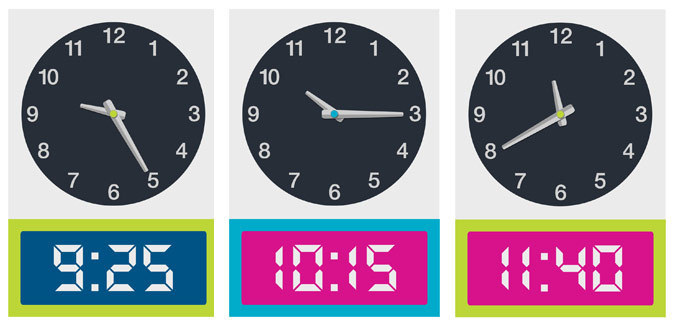Math
While we have finished learning about fractions specifically in math, we are still continuing to make references to fractional names and equal parts as we explore our new topic of time. We will learn about time next week before we begin to explore adding and subtracting money after the Easter break.
Students in Grade Two are learning to tell time to the hour, half hour, quarter after and quarter to.
Students in Grade Three are reviewing telling time to the hour, half, hour, quarter after and quarter to, as well as learning how to tell time to 5 minute intervals.
Understanding how the clock works, and telling time accurately is a skill that students acquire over....time! I do not expect students to become experts on telling time in the week we spend focusing on it during our 60 minute math block. This is why we have been making reference to time in our Morning Brain work since September! Telling time is also a skill that can easily be supported at home, as I'm sure many parents do. Having an analogue clock in your house, or having your child wear a watch that shows analogue time is helpful for students in Grades 2 and 3.
Social Studies
This week we began learning about our new topics in social studies! Students in Grade Two are learning about Global Communities. This week we focused specifically on Salvador, Brazil. Students in Grade Three are learning about the three land form regions in Ontario. This week we began by exploring the Hudson Bay Lowlands.
Students have been using the Nelson Literacy Resources to build their knowledge about these new places. We have been looking specifically at how the climate, physical features/land form features, and natural resources in these places affects the people living there. After students have gathered information we have a Knowledge Building talk where students share their own ideas, connections, and questions, in a whole class conversation. As the teacher I step back and allow the students to run the conversation.
Today we actually explored Salvador, and some of the communities in the Hudson Bay Lowlands (Moose Factory, Fort Severn, etc.) using google maps street view! This is a fantastic tool for exploring different places in our world and we will continue to use it during our learning in this unit.
Literacy
We spent the first half of this week reviewing the various text features in non-fiction books. Students created posters that we displayed in the classroom to remind ourselves of how these special features help us when we are reading.
Also this week students chose topics that they will become experts about as we learn how to write non-fiction books. So far students have chosen a book that will help them gather information. They have had time to read their books, teach other students about their topic, and write as much as they can about their topic. Next week we will learn how to develop a table of contents that will guide us into organize our learning into chapters and then gathering more information to write those chapters.
Students are encouraged to learn more about their topic at home by searching on the internet ( The encyclopedia Britannica on the YRDSB website is an excellent tool. Click here to check it out. Visiting the Aurora Public Library is also a wonderful idea to support this learning if possible.
Request
We are in need of a couple of old cotton shirts that can be used as rags in our classroom for water spills. If you have an old cotton shirt, or one already cut into rags that we could have it would be greatly appreciated!






No comments:
Post a Comment
Note: only a member of this blog may post a comment.